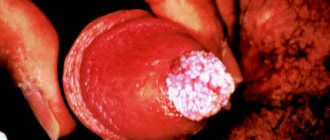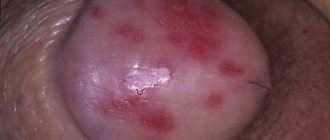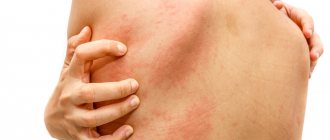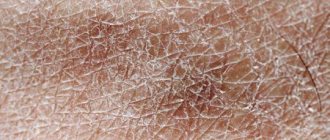Dermatology
5167
no comments
At least once in his life, every man has encountered some problem regarding his manhood. Discussions of this kind of problem, as a rule, are not made public, and even if they were told to a loved one, the insider is not always able to give the right advice. The most correct decision in this situation would not be to search for answers to your questions on the Internet, among friends and acquaintances, but to visit a specialist in this field. In this article we will consider such a problem as the appearance of white spots on the penis.
Reasons for appearance
For any man, it is extremely important to monitor his health, and especially to pay a lot of attention to the genitals. New growths on the penis are not always a bad sign, but this does not mean that they should not be given due attention.
Sometimes serious illnesses begin with simple small white dots. Urologists identify several possible causes of this disease.
These include:
- Insufficient hygiene of intimate areas of the body. The skin of the head of the penis is very sensitive and has many secretion cells. They constantly secrete spegma, which quickly dries out and accompanies the development of inflammation and other skin diseases. Often because of this, white spots appear on the head of the penis.
- Fordyce granules are white formations on the male genital organ without itching or pain. They appear on their own during the puberty of a young man. This happens because a sharp influx of testosterone appears in a young body, and it contributes to the accelerated functioning of the sebaceous glands. Fordyce granules are not a disease and do not require treatment.
- Unprotected sex resulting in an infectious disease of the genital organs. For example, symptoms of gonorrhea, genital herpes, chlamydia and syphilis include red and white dots on the glans and foreskin. To ensure that the diagnosis is correct, it is recommended that you consult a medical specialist.
- Candidiasis can cause white growths on the head of the phallus in men.
- Sometimes the appearance of white dots is a physiological process and absolutely normal. These may be small changes in the hair follicles or sebaceous glands. Neither requires any intervention until visible irritation or inflammation occurs.
White dots, what are they?
This concept encodes many different manifestations. So, by “dots” we mean curdled discharge due to candidiasis or fatty papules.
Types of white dots:
- Accumulations of secretions. The penis is surrounded by glands that produce various secretory fluids. If hygiene is insufficient, they dry out, forming white crusts or clumping at the base of the foreskin. The discharge may contain both natural and bacterial flora. When infected, a man usually experiences other symptoms: itching, redness of the head.
- Papules. Small tubercles are dense to the touch. When conducting diagnostics, they turn out to be hair follicles, sebaceous glands located close to the surface of the skin, and benign formations (lipomas). The abundance of such papules is observed in the transitional adolescence period, when, against the background of hormonal changes in the body, the functioning of the sebaceous glands is disrupted. They can become clogged and inflamed. In some cases, surgery is required.
- Peeling. Together with itching, it can be caused by allergies or infection.
- Smooth spots and dots. Smooth whitish lesions are characteristic of vitiligo - an autoimmune disease in which coloring pigment disappears in some areas of the skin. As a rule, it appears not only on the penis, but also on other parts of the body. Lichen also appears as smooth spots, in this case its subtype called scleroatrophic.
- Sores. A sign of a bacterial infection. Ulcers are manifested by diseases such as syphilis and gonorrhea, as well as balanitis, which occurs due to untimely hygiene.
- Protruding erosive plaques. This description is suitable for herpes and human papillomavirus infection (HPV). The latter is dangerous because some of its forms can quickly become malignant and degenerate into tumors.
Whiteheads are not always pathogenic, but in some cases they require immediate attention.
Symptoms of pathology
Neoplasms can be not only in the form of small white dots. Patients note the appearance of:
- condylomas with sharp ends;
- pimples with white “heads”;
- pearly or pearly papules on the head;
- the bumps are pink or pale;
- pronounced modifications of irregular shape occur during the disease - molluscum contagiosum.
You can see the diseases and signs in the photo. Typically, the location of all new formations on the skin of the penis is on the shaft or on, around and under the head.
Having so many possible causes, how can you figure out when you should contact a urologist and when you can ignore it? Basically, all pathologies have more than one symptom, so you should not be afraid of the appearance of just small dots.
Intervention is required if the following occurs:
- Significant and persistent itching in the area of the tumor.
- Burning and pain during urination.
- Swelling, redness, or peeling of the skin of the penis.
- Foul-smelling and unpleasant discharge from the urethra.
- Painful sensations during and after sexual intercourse.
- Common, standard symptoms: fatigue, physical and mental weakness, fever, migraine and dizziness, poor concentration.
Another clear sign of a pathology that requires urgent treatment is that white dots on the head of the penis do not go away for more than 2 weeks, moreover, the other above-mentioned signs are added to them.
Prevention
It’s easy to protect yourself from the disease. You should monitor your intimate hygiene every day, lead a healthy lifestyle, do not abuse alcoholic beverages, and always use protection during sexual intercourse.
There are other methods of prevention:
- A systematic personal visit to a doctor who deals with the reproductive system, at least once a year. This will help detect deviations as quickly as possible and eliminate them at an early stage.
- Maintaining immunity: playing sports, hardening, taking vitamins.
- Avoid synthetic underwear. The fact is that cotton does not interfere with the breathing of the skin and does not irritate it, unlike any other material.
Why do spots appear on the penis?
Normally, the skin and mucous membrane of the male genital organ should have a uniform color. But sometimes strange spots appear on the head or foreskin. This phenomenon may be due to a number of reasons.
Of course, it is quite difficult to determine on your own what exactly causes the changes in the skin and mucous membranes of the intimate organs. If you find pimples, spots or red spots on the head of the penis, it is better to consult a doctor.
Insufficient hygiene in men
Surprisingly, many modern men pay insufficient attention to their own hygiene or carry out basic hygiene measures not very correctly, which can lead to various unpleasant changes on the genital organ. In particular, irregular washing or changing linen can lead to the development of irritation of delicate mucous membranes, which can cause reddish spots to form on the skin, causing discomfort. If you ignore this situation, you may encounter quite severe inflammation.
Stains can also appear due to excessive washing, but this is rather an exception. Although urologists strongly do not recommend washing the head of the penis with a washcloth and regular soap, as they have a pronounced irritating effect.
Men should perform daily toileting of the genitals, and also regularly change their underwear to fresh ones. If you do not have access to water, you can use wet hypoallergenic wipes.
Allergic dermatitis
Most often, isolated allergic reactions on the penis occur due to the local influence of irritants (specifically on the genital area). Unpleasant symptoms can be caused by:
- Personal hygiene products, especially if they contain a lot of preservatives, fragrances, and dyes.
- Underwear made of synthetic fabric. Most often, unpleasant allergy symptoms in this case appear in men who sleep naked.
- Insufficiently washed bedding or underwear (if there are particles of washing powder left in it).
- Medicines for topical use. A variety of gels, ointments and creams can also cause severe allergy symptoms.
- Products for intimate life. Allergies can develop to condoms, as well as female contraceptives, lubricants used, fragrances, etc.
Typical symptoms of penile allergies include red patches, some swelling, a rash, and severe itching. When treating such a problem, it is very important to promptly identify the factor that led to the occurrence of unpleasant symptoms and eliminate it.
Red plaque with psoriasis
Penile psoriasis is a chronic non-infectious disease, the causes of which are still unknown to scientists. This disease, fortunately, is not contagious, although it can cause a lot of discomfort. The development of the disease can begin with the appearance on the head or shaft of the penis of pinpoint redness or a rash that itches noticeably. Sometimes psoriasis progresses very quickly, and the patient may suddenly notice a red spot with clear contours on the edge of the penis. Scales may be visible on it - evidence of disturbances in the process of keratinization of the skin. Sometimes the spot simply looks like a red plaque without peeling, raised above the level of healthy mucosa.
Sometimes dermatovenerologists have difficulty diagnosing psoriasis on the genitals, since with such localization the disease can occur with disturbed symptoms. However, all scrapings from the affected area show the absence of infectious agents.
Itching with genital herpes
Herpes on the genitals occurs due to the activity of the herpes simplex virus. You can become infected with it through sexual contact or by transferring viral particles from the lips (where herpes blisters most often appear) or from common objects. The disease can manifest itself:
- The appearance of red dots on the head and shaft of the genital organ.
- The occurrence of itching, pain and burning at the site of spot formation.
- Specific discharge from the urethra.
- Enlarged lymph nodes.
- Symptoms of intoxication: fever, weakness, aches, etc.
Quite quickly, red spots on the mucous membranes become blisters. At this time, the burning sensation is especially pronounced. After a few days, the bubbles burst, leaving behind crusts that fall off on their own.
Genital herpes is highly contagious. Treatment of such a disease is symptomatic and does not help in any way to expel the virus from the body.
Spots and white plaque with thrush
Candidiasis is a fairly common fungal disease that is more often diagnosed in women than in men. But in the presence of predisposing factors (for example, decreased immunity), this disease may well develop in representatives of the stronger sex. Its main culprit is yeast-like fungi from the genus Candida. If they multiply excessively, a man may experience characteristic symptoms of the disease:
- The appearance of red spots on the head of the penis without clearly defined boundaries. This symptom is often accompanied by swelling.
- The appearance of pain during urination, erection, and sexual intercourse.
- The occurrence of itching and noticeable burning.
- The appearance of a specific white coating, which has a curd consistency and is distinguished by a pronounced sour odor.
The appearance of symptoms of thrush requires consultation with a doctor and abstinence from sexual activity for the entire period of treatment. Sometimes the disease can be managed only with the help of local medications and some lifestyle changes.
Damage to the foreskin with balanoposthitis
In general, the term “balanoposthitis” is used to refer to an inflammatory process localized on the glans penis and foreskin. This condition can be provoked by various bacteria, viruses and fungi, and often occurs against the background of a variety of health problems that reduce the overall resistance of the body. Typical symptoms of balanoposthitis:
- Changes in the condition of the head of the penis. Cracks and erosions, red dots and spots appear on it. The foreskin may narrow, making it difficult to expose the head.
- Minor skin changes. Redness and swelling of the penis may occur.
- The occurrence of pathological discharges of various types, including purulent ones.
An experienced doctor will help to identify the factor that led to the development of balanoposthitis and correct it. Attempts at self-medication can lead to the development of chronic health problems and various complications.
Syphilis on the male organ
Today, syphilis is not a very common sexually transmitted disease, however, with promiscuous sexual intercourse, a man has a risk of contracting it. This disease is caused by Treponema pallidum and manifests itself with quite specific symptoms:
- At the site where the pathogen enters the body, a sore appears, which is called syphiloma. It is also called chancroid. Primary syphiloma looks like an ulcer or erosion of a round or oval shape. It has a shiny and smooth bottom. Often such a neoplasm is localized on the glans penis or foreskin, but can also form in the oral cavity. Its edges are slightly raised above the skin. This type of chancre does not cause any discomfort or pain.
- A few days after the formation of primary syphiloma, the lymph nodes near the site of the lesion may enlarge.
- In the absence of therapy, the chancre may disappear without a trace, and the lymph nodes may shrink. In the future, the disease can manifest itself as a rash of various types throughout the body - secondary syphilomas.
Syphilis is now relatively easy to treat. Therefore, if you suspect the possible development of such an illness, you should not be afraid, but rather seek help from doctors as soon as possible.
Small genital warts
Condylomas are small growths on the skin and mucous membranes that arise due to the activity of HPV (human papillomavirus) in the body. This pathogen is very easily transmitted from person to person, including during sexual intercourse. Scientists are confident that it is present in the body of most adults. But the disease does not always manifest itself. Condylomas can appear on the body due to a decrease in the body's defenses. They can be localized:
- Directly on the head or shaft of the penis.
- On the mucous membranes of the inner layer of the foreskin.
- On the skin of the scrotum or perineum.
- Near the anus.
Before obvious signs of the disease appear, strange spots of light pink and reddish color may form on the skin. Over time they become growths. The condylomas themselves do not hurt or itch (only occasionally does itching occur when they appear); they look like pointed tubercles of flesh-colored or pink color and may slightly increase in size over time. However, such neoplasms are potentially dangerous from the point of malignancy; doctors prefer to remove them using various methods of exposure.
To prevent the reappearance of condylomas, immunostrengthening and antiviral treatment is carried out, but it is not possible to completely expel HPV from the body.
Pink pimples due to molluscum contagiosum
Molluscum contagiosum is a viral disease that can be transmitted from person to person through simple skin contact. This disease is typical for children, but it can also develop in adults, for example, with a decrease in immunity. The main manifestations of this disease are rashes in the form of pink spots-pimples, which are pink in color and size from 1 mm to 1.5 cm. The rash can appear on the skin after several weeks or months for infection. If you press on one of the elements of the rash, a specific thick mass of white color will stand out from it.
Unfortunately, molluscum contagiosum is not treated with any specific methods of treatment. This disease requires especially careful hygiene and strengthening the immune system. Manifestations of the disease may well disappear on their own, but sometimes doctors insist on their surgical removal.
Neoplasms
There are quite a few types of benign tumors that can form on the male genital organ. However, a much greater danger is posed by possible cancerous tumors. Oncology can be suspected by the appearance of:
- Unexplained rashes or spots that appear for no apparent reason and do not go away.
- Thickened area of skin.
- Bleeding, including from the urethra.
- Sores.
- Accumulations of contents under the foreskin.
- Bumps or warts.
Sometimes swelling of the penis and enlarged lymph nodes in the groin can also indicate cancer.
Of course, the appearance of the described symptoms does not indicate 100% the development of cancer. But nevertheless, when faced with incomprehensible signs, it is better to be vigilant and consult a doctor.
Diagnostics
Diagnosis begins with a visit to a competent medical specialist. The doctor must listen to all complaints and conduct an examination, and then prescribe urine and blood tests: general and biochemical, and prescribe primary treatment. When purulent discharge is observed from the urethra or from the points themselves, a sample is taken.
Which doctor should I contact:
- All incidents immediately after sexual contact are examined by a venereologist.
- A dermatologist deals with the appearance of itching and flaking if the patient is sure that they did not appear after sex and do not go away for more than two weeks.
- They turn to a urologist when the disease has already taken a severe form - the presence of foul-smelling discharge, pain and burning sensation when touching and urinating, swelling of the penis.
- A visit to the doctor is not required if the tumors appear for no apparent reason and do not cause any discomfort.
Therapy tactics
Treatment of any spots and red dots on the head or shaft of the penis should be carried out after accurately determining the causes of such symptoms. Treatment methods may vary. To identify the causes of illness, the doctor may:
- Examine the patient.
- Examine scrapings and smears.
- Conduct additional research, for example, bacterial culture or biopsy.
- Examine blood for the presence of antibodies, etc.
If you find spots on your penis, you should contact a urologist or dermatovenerologist at the nearest clinic.
How to help with allergies?
If there is a suspicion that the unpleasant symptoms were caused by allergic reactions, eliminating it will not be very difficult:
- It is important to identify the allergen and exclude further contact with it.
- To eliminate spots, itching and burning, you should take antihistamines (for allergies). It is worth giving preference to modern drugs, for example, based on loratadine, cetirizine, etc.
Local treatment of penile allergy is not advisable. It is allowed to use Fenistil gel with antihistamine properties and Bepanten cream to accelerate skin recovery.
How to treat STDs?
Treatment of various sexually transmitted diseases can be carried out:
- With the help of antibiotics. Such treatment will be needed if necessary to stop syphilis, gonorrhea and trichomoniasis.
- With the help of antimycotic (antifungal) drugs. Similar medications in tablet or local form are used for thrush.
- Antiviral drugs. Doctors prescribe such medications to patients with HPV, molluscum contagiosum, and genital herpes.
In addition to targeted etiotropic treatment, patients with STDs are often recommended to take measures to strengthen the immune system, in particular, give up bad habits, adhere to proper nutrition and an adequate daily routine, and also take immunomodulators, vitamins and other medications in accordance with medical recommendations.
When treating any STD, therapy should be parallel. Both partners have to take medications, and sexual intercourse is contraindicated until recovery.
Solution
Just as there are many types of pathology, there are also many treatment methods. The choice of the right one depends on the causes and severity of the disease. The patient can choose what is acceptable for himself, but sometimes, in order to solve the problem, one must act quickly and radically.
How to remove new formations on the genital phallus:
- Medication is the simple and standard use of various antibacterial drugs. Sometimes your healthcare professional will recommend combining medications with herbal baths to soothe itching and irritation. It is important to remember that it is not recommended to use this or that product without a doctor’s prescription. This can lead to serious and irreparable consequences or interfere with treatment.
- Operative - the method is used only if the situation is considered severe. The surgical method uses laser or surgical removal. The operation is performed under local anesthesia and, as a rule, unpleasant scars are often left on the skin.
Types of neoplasms and their treatment
If the white growths are caused by genital herpes, the complex results in an itching syndrome and sometimes pain, especially if they are rubbed by underwear. Such pimples quickly turn watery, and eventually burst, leaving behind weeping wounds.
A white spot on the labia majora or labia minora is a characteristic sign of condyloma or papilloma. In this case, the neoplasm has a sharp tip, a color that does not differ from healthy skin and mucous membranes.
Pain and itching syndromes do not occur, but there is a risk of degeneration into oncology due to constant friction with underwear.
Fordyce granules are seborrheic cysts that are uniform in size, light in color and small in size. Photo symptoms of neoplasms can be found on relevant forums or special medical websites.
Treatment
Features of treatment of neoplasms are determined taking into account the cause of their occurrence. So, if they are caused by non-compliance with hygiene rules, it is sufficient to correct the latter with daily water procedures and the use of antiseptic hygiene products.
Miliaria can be treated with special drying preparations or regular baby powder.
More serious diseases that are viral or bacterial in nature require specific treatment, which is prescribed by a doctor, based on the stage and nature of development.
- If there is no suggestion that the growths are caused by an infectious disease, it is recommended to treat the rash with a disinfectant solution. In case of an allergic reaction, take antihistamines, and in case of hormonal imbalance, take corticosteroids prescribed by a doctor.
- For any etiology of the rash, it is recommended to take vitamin complexes and immunomodulators, which increase the body’s protective function, thereby accelerating recovery.
- Papillomas and condylomas are removed by laser or cryodestruction. Radical surgery is performed in exceptional cases. After removal of the tumor, it is subjected to histological analysis, which will determine the nature of the tumor (malignant or benign).
- If the cause of the rash is the development of molluscum contagiosum, they resort to the use of liquid nitrogen or laser techniques. Pimples caused by genital herpes are lubricated with special antiviral ointments. It could be Acic or Acyclovir.
- If the diagnosis of Fordyce granules is confirmed, laser or cryodestruction is prescribed.
Preventive recommendations
- To avoid the appearance of white rashes on the labia minora, you must follow some simple rules. First of all, this is personal hygiene. It is recommended to take a shower daily in the morning and evening, and more often during the hot season. If an unnatural rash is detected, it is recommended to use only those products that do not provoke an allergic reaction, that is, without dyes or fragrances in the composition.
- Underwear should be made of natural material and should not compress the genitals. It is better to choose products made from cotton - a material that allows air to pass through well and prevents the “greenhouse effect”.
- Panty liners and panty liners should not contain fragrances. These products are changed every 4 hours. Shaving of hair in the genital area is carried out along the line of the integument with a special epilator. A regular razor often causes irritation. To remove hair, it is recommended to use special depilatory products.
Conclusion
If you cannot avoid the appearance of a rash on the labia minora, you should not self-medicate, but should immediately consult a doctor. Only comprehensive treatment of the symptom will help achieve a speedy recovery.
In addition, if there is improvement and most of the tumors have disappeared, there is no need to stop treatment prematurely.
It must be remembered that even after complete elimination of the cause of the rash, the problem may return again. Therefore, it is important to follow preventive recommendations on an ongoing basis. It is easier to prevent any disease than to quickly deal with it and its negative consequences.
How to determine the cause of a symptom
Before determining how to treat and how to remove an unpleasant symptom, the doctor prescribes a number of diagnostic measures that allow you to make the correct diagnosis.
First of all, the penis is examined, determining the nature of the clinical manifestation, its prevalence, and accompanying symptoms.
Further laboratory tests are carried out:
- a blood test, the results of which can detect the development of an inflammatory process in the body;
- histological examination of a sample of biological material taken from the surface of the skin;
- blood test for the presence of viral particles characteristic of HIV;
- microscopic examination of a biopsy sample taken, that is, plaque;
- serological analysis;
- biopsy of an enlarged inguinal lymph node, if such a symptom is present.
Once a final diagnosis is made, appropriate treatment is prescribed. In most cases, they are limited to conservative methods. If necessary, physiotherapeutic procedures are prescribed.










